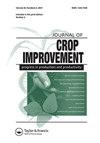Phenotypic diversity, heritability, and association of characters in sugarcane genotypes at Metehara Sugar Estate, Ethiopia
IF 1.5
Q3 AGRONOMY
引用次数: 1
Abstract
ABSTRACT Genetic improvement of sugarcane (Saccharum spp. hybrids) yield is crucial in the improvement of crop productivity. This study was conducted with the objectives to estimate the degree of phenotypic diversity, heritability, and association of various traits and recommend sugarcane genotypes for commercial production and small-scale farmers. Fifteen sugarcane genotypes and one standard check variety were evaluated in plant, first and second ratoon crops for 14 quantitative traits including stalk and juice quality. Highly significant (p ≤ 0.01) differences among the genotypes for all the traits were observed. Phenotypic diversity of genotypes by principal component analysis (PCA) and cluster analysis indicated genetically diverse genotypes from divergent cluster groups, which can be exploited as desirable parents to use in hybridization programs. All traits had low to high correlations (r = 0.132 to 0.719) with cane yield. High broad-sense heritability (h2) was detected for single cane weight (82.55), number of millable canes (76.85), plant height (76.79), stalk diameter (73.22), and internode length (73.69) indicating that these traits could be selected for easily. Highest expected genetic gains were recorded in single cane weight (30.12) and number of millable canes (28.6). Path coefficient analysis of cane yield revealed that single cane weight and number of millable canes were the major contributors to cane yield. Results showed that millable cane number and single cane weight can be used as reliable selection criteria to improve sugarcane yield. Genotypes FG03104, FG05414, and FG05300 can be considered for commercial production at Metehara Sugar Estate and similar agroecologies.埃塞俄比亚Metehara Sugar Estate甘蔗基因型的表型多样性、遗传力和性状关联
甘蔗(Saccharum spp.杂种)产量的遗传改良是提高作物生产力的关键。本研究的目的是评估表型多样性、遗传力和各种性状的关联程度,并为商业生产和小农推荐甘蔗基因型。对15个甘蔗基因型和1个标准检验品种在植株、一、二代作物上进行了茎秆和汁品质等14个数量性状的评价。各性状基因型间差异极显著(p≤0.01)。主成分分析(PCA)和聚类分析的基因型表型多样性表明,不同聚类群体的基因型具有遗传多样性,可以作为理想的亲本用于杂交项目。各性状与甘蔗产量呈低至高相关(r = 0.132 ~ 0.719)。单株重(82.55)、可分株数(76.85)、株高(76.79)、茎粗(73.22)和节间长(73.69)的广义遗传力较高,说明这些性状可以很容易地选择。单株重(30.12)和可产蔗数(28.6)的预期遗传收益最高。甘蔗产量通径系数分析表明,单株重和可蔗数是影响甘蔗产量的主要因素。结果表明,可蔗数和单株重可作为提高甘蔗产量的可靠选择标准。基因型FG03104、FG05414和FG05300可以考虑在梅特拉糖业庄园和类似的农业生态中进行商业化生产。
本文章由计算机程序翻译,如有差异,请以英文原文为准。
求助全文
约1分钟内获得全文
求助全文
来源期刊

Journal of Crop Improvement
Multiple-
CiteScore
3.30
自引率
7.70%
发文量
42
期刊介绍:
Journal of Crop Science and Biotechnology (JCSB) is a peer-reviewed international journal published four times a year. JCSB publishes novel and advanced original research articles on topics related to the production science of field crops and resource plants, including cropping systems, sustainable agriculture, environmental change, post-harvest management, biodiversity, crop improvement, and recent advances in physiology and molecular biology. Also covered are related subjects in a wide range of sciences such as the ecological and physiological aspects of crop production and genetic, breeding, and biotechnological approaches for crop improvement.
 求助内容:
求助内容: 应助结果提醒方式:
应助结果提醒方式:


